Hesperian Health Guides
Learning to Move and Smile, the Story of Teresa
HealthWiki > Disabled Village Children > Chapter 16: Juvenile Arthritis: Chronic Arthritis in Children > Learning to Move and Smile, the Story of Teresa
Teresa has had juvenile arthritis since age 7. When her mother first brought her to PROJIMO from a distant village at age 14, her body had stiffened into the shape of a chair. Her eyes were the only parts of her body she could move. Her joints hurt her so much that she spent every night crying. Years before, a doctor had prescribed aspirin for her pain. But the aspirin began to give her severe stomach pain, so she stopped taking it.
Once Teresa was a cheerful, active little girl. She had completed 3 years of school. Now she was sad and felt hopeless. She would cry out with pain each morning when her father carefully lifted her out of bed and sat her in a chair. She rarely spoke and never smiled.
When Teresa arrived at PROJIMO she had severe contractures of her wrists, fingers, elbows, hips, knees, ankles, and feet. The rehabilitation team had her start using aspirin again, but with care that she take it with meals, lots of water, and an antacid. They then began a long, slow process of therapy, part of which we show in the following photos.
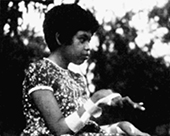 |
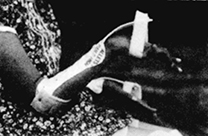 |
| To help correct her wrist contractures, visiting therapists made these splints for her out of costly plastic. | However, to the therapists’ surprise, they found out that these low-cost splints made by villagers from a plastic bucket worked better. |
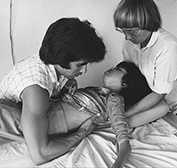 |
They also made leg splints out of plastic buckets and strips of rubber tire tube. | 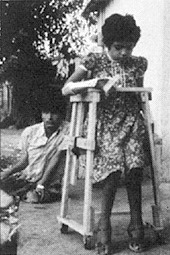 |
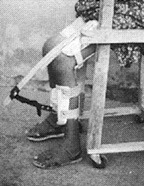 | ||
| Every day the team spent several hours with Teresa, gently doing range-of-motion, stretching, and strengthening exercises. Here a visiting physical therapist teaches a village worker how to help Teresa increase movement in her stiff neck and back. | When Teresa could move her joints some, the team made her an adjustable walker. It had shoulder supports and a saddle seat that could be raised as her legs straightened. She learned to walk by pushing herself backward. This strengthened the muscles that straighten her legs. | |
Teresa was improving steadily. She began to talk, smile, and to take interest in things. An older brother came to visit for a few weeks. He learned about her exercises and therapy so he could help her when they returned to their village.
Unfortunately, soon after Teresa went home she became ill with dengue (break bone fever) and nearly died. Her family stopped both exercises and medicines. When she returned to PROJIMO 6 weeks later, she was as stiff and bent as when she first came. She was so depressed she spoke to no one. The team began her rehabilitation all over again.
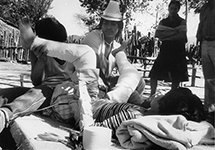 |
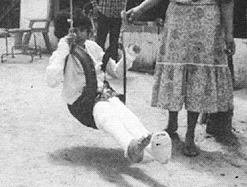 |
| This time they straightened her legs and arms with plaster casts (see Chapter 59). They changed the casts every 2 days. With each cast change her joints were exercised. | Finally, with the casts, Teresa’s knees and wrists became fairly straight. She now had some hand movement and could play in the playground. |
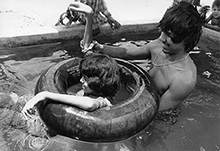 |
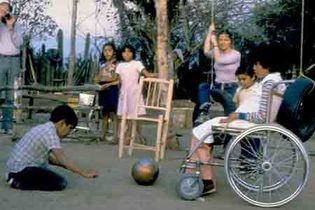 |
| Exercise in the therapy pool at PROJIMO was fun and greatly improved her movement | Kicking balls with other children with disabilities helped Teresa strengthen muscles that straighten legs. |
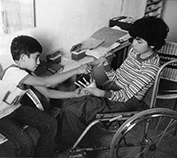 |
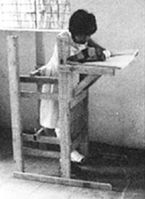 |
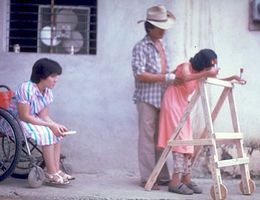 |
| Village children help her with activities to use her hands. Here she weaves a basket. | When her legs were stronger, the team made an adjustable standing frame for her. | Later Teresa began to walk using a homemade walker with wood wheels. She wore leg braces for support. |
As Teresa’s legs and arms straightened, her neck bent forward more and more. She could not lift her chin from her chest. The village workers made her a head support, attached to a firm cloth around her chest. Over a period of months, the support gently brought up her head.
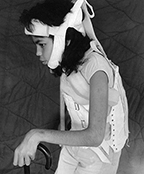 |
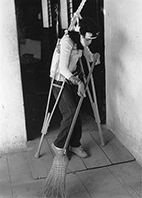 |
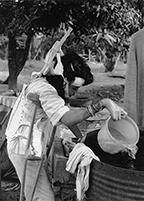 |
| Teresa is now able to walk with crutches. Through daily work she gets much of the same therapy she gets doing her exercises. |
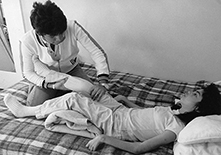 |
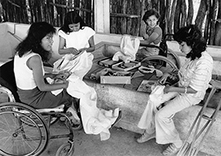 |
| She also continues with her daily exercises to straighten and strengthen her arms and legs. | Sewing together with her friends helps Teresa improve the use of her hands. She is also gaining skills with her therapy. (5 photos by Richard Parker) |
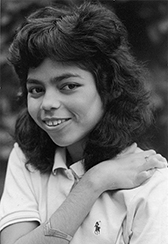 |
At home, Teresa now helps care for her younger brothers and sisters. She and her family share the household tasks. Before, others had to take care of her.
|


